VIDYABEN SHAH & MANUBHAI SHAH
Freedom Struggle
Manubhai in the Freedom Struggle
Inspired by Gandhiji, initially Manubhai wanted to study Law, but his father advised him to become an engineer as the family was very large and would require better financial support than what a lawyer might provide in those days. But subsequently while studying for the B.Tech degree in Chemical Engineering at the University Department for Chemical Technology (UDCT) in Mumbai, Manubhai realised his genius and love for mathematics the study of which he decided to pursue after B.Tech. This was however to put him in a spot as events unfolded. In 1936 when Manubhai was about to complete his studies at the UDCT in Mumbai, Sir Lala Shri Ram (Lalaji) of the Delhi Cloth Mills (DCM) arrived at the UDCT on a recruitment mission and interviewed Manubhai for a post of Chemist cum Textile Engineer at DCM. After an hour long interview, Manubhai declined to go to Delhi due to his idea to study further and was already looking for funding to go to University of Cambridge to do a Mathematical Tripos with the aim of becoming a Senior Wrangler in Mathematics. Lalaji however persisted through the then UDCT Director Dr R B Foster to recruit Manubhai who relented and joined DCM in 1937. Very soon Manubhai displayed his entrepreneurial abilities and sharp intelligence. Having thoroughly researched and deeply understood the chemical and other processes of textile and garment production from raw material to yarn to looms to garment making, he contributed to the setting up of a research unit which was the forerunner to what is now the Shriram Institute for Industrial Research and several modern units of production and exports including exports of the USHA Sewing Machine which has since been an international brand of sewing machines. Lalaji also took his advice on an everyday basis in expanding the scope of DCM. Manubhai’s contribution to Indian industry was growing in leaps when the call from Gandhi came for the youth and young professionals to court arrest and join the Quit India Movement in 1942.
Since 1926, Manubhai was already engaged in some form of agitation for independence, when Gandhiji had visited his home town Wadhwaan giving a call to boycott videshi cloth. Though only 11 years old, Manubhai along with others collected videshi clothes thrown away by people and set them afire. Again in 1940 Manubhai met Gandhiji when the call for "Individual Satyagraha" was given and he asked Gandhiji's permission to join the Satyagraha. But Gandhiji told him to wait and that he would be sent for when the time was right. At the more mature age of 27 years in 1942, however, Manubhai’s career as engineer and entrepreneur came to an abrupt halt as he was zealously drawn to the call for country and plunged totally into the Quit India Movement, after assuring Lalaji that he would be back to DCM after India gained independence, though at that moment no one could predict how long the Freedom Movement would take to force the British to leave India. Manubhai’s first action was to lead a workers’ strike in DCM as part of civil disobedience. Following that he was involved in numerous underground activities until his imprisonment, although civil disobedience and exhorting more and more students and workers, women and men, to join him were his key activities in the movement. Picketing, processions and strikes were organised on a daily basis. He worked as Chief Organiser in the Movement and a large number of workers from DCM and other businesses took part in numerous protests under Manubhai's leadership. He also motivated thousands of students from Delhi University colleges such as St Stephens College and Hindu College to join programmes organised by him, some of which involved occasional closing of schools and colleges as tokens of non-violent protest.
In characteristic style of action after action, Manubhai plunged into the Quit India MovementOn 11th August 1942, two days after Gandhiji's call to 'do or die', Manubhai plunged into action with the utmost energy and zeal. A procession of over 5000 mill workers was led by Manubhai and on the way to Chandni Chowk thousands of people from the public joined them. At the Kotwali, a big police force was led by Inspector General of Police Mr Killburn and on the loudspeaker he ordered the procession to halt. There were loud exchanges between the police and the public and a huge uproar spread throughout the city as Killburn threatened to open fire. In another set of actions, the All India Radio which was based in Metcalfe House in Civil Lines was forced to shut down for a few days. Manubhai and his comrades also closed the Shahadara Station for a few hours. In November 1942 they prevented the Frontier Mail from entering Delhi and stopped the train by removing a fish plate from the rail tracks. One important programme initiated by Manubhai was to boycott British currency, and a procession of more than 2000 students tore many currency notes in front of the Imperial Bank of India Headquarters in Delhi. On 9th December 1942, ten groups were organised with seven people in each group to try and crack the windows of ten foreign shops in Connaught Place to make it inconvenient for the shop owners to function. Not all the actions remained non-violent to the consternation of Gandhiji. As soon as the activists had done their work, sirens rang out and they ran to the side lanes of Connaught Circus to change into plain khadi clothes and joined other passers-by in the area. On 31st December 1942, Manubhai organised changing of 5000 name plates of roads which had British names on them and replaced them with names such as Gandhi, Sardar Patel, Nehru and Subhash Bose. In the Hindustan Times press where Gandhiji's son Devdas Gandhi was the editor, names of the Indian leaders were printed on labels and the existing road name plates were covered with these new labels. In addition posters showing various slogans were printed in large numbers at the press and these posters were put up through the night all across Delhi. The police was in great puzzlement as to how so many programmes were being executed in such a short time, even in just one night.
Once the British authorities became aware of any freedom activist, the activist had to work underground in disguise to avoid being arrested. As Manubhai's activities became known, a reward was announced for his arrest and he started to work underground. He had to keep changing his disguises wearing beard of different sizes or changing style of clothes and wearing the fez cap. On one occasion when he was leading a procession, someone leaked the news as to which locality he was in. As the police went after him he rushed to a barber's shop in Connaught Place to change to a clean shaven appearance and escaped and hid in the house of architect Shri Narendra Kothari in Connaught Circus. There is a story often recounted in Gujarati circles in Delhi, where the dhobi used to put people's names on their clothes and had put Manubhai's name on his shirt. The police in their search would invariably check the clothes the dhobis would have collected. Once the police found the name Shah on one shirt which had been washed by the dhobi of Mr Kothari; the dhobi was identified and taken to the police station for interrogation and this put a lot of fear in the minds of many Gujaratis in Delhi that they may get arrested. Sometimes Manubhai would hide in the house of Sudhakarji at 12 Todarmal Road near Bengali Market. Sudhakarji's daughter and wife of the renowned homeopath Dr Jugal Kishore, Sharda was later to be arrested for her own work as a freedom fighter.
Subsequently, Manubhai's photos had also been put out and shoot at sight orders had been issued against him. It had become increasingly dangerous for him but he carried on with the non-cooperation and civil disobedience work which often would be jointly planned with activists such as Aruna Asaf Ali, B V Keskar and others, but he managed to avoid arrest, until in return for a pardon a worker pointed to the police who Shahji (as he had come to be known) was and he was caught in the crowded area near Fatehpuri Masjid in Chandni Chowk.
Manubhai’s activities as a Freedom Fighter had been manifold depending on the need of the hour, including gathering people for demonstrations, creating civil disobedience and chaos to make it unmanageable for the British to rule India, giving speeches (which had become very much his favourite activity) and seeking co-operation of Indian peoples to close shops, markets and factories in protest, and participating in discussions with other activists and preparing documents on building a modern independent India.
Through the Freedom Movement Manubhai had become close friends with Biju Patnaik (later to have become Chief Minister of Orissa) and Hemwati Nandan Bahuguna (later Chief Minister of Uttar Pradesh), and one night along with
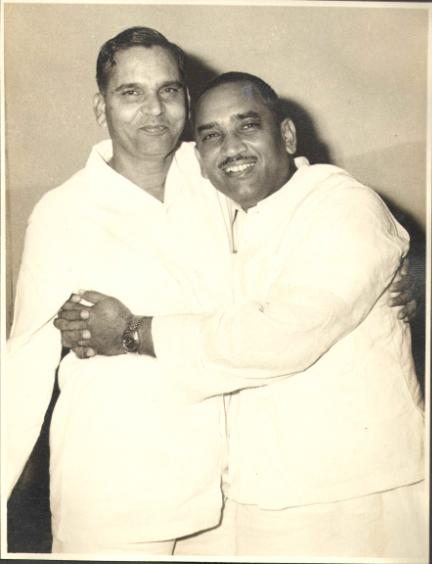
His vision, courage and persistence became well known in conducting of rallies, changing of road names, encouraging boycotting of foreign goods, preparing posters, giving speeches, writing articles in newsletters and printing pamphlets and drawing up documents for the future of India. He also worked underground very closely with the freedom fighters Aruna Asaf Ali and Jayaprakash Narayan, both of whom throughout their lives remained close friends with Vidyaben and Manubhai.
Manubhai imprisoned
After IGP Killburn's police managed to arrest Manubhai on 9 January 1943, he was put in a cell in the Red Fort jail in Delhi. On hearing about Manubhai's imprisonment, Lala Shri Ram tried to send him his salary on the basis of paid leave but Manubhai refused to accept it. He remained in prison for

On one of the nights in prison when bread came wrapped in a piece of newspaper, Manubhai read that Gandhiji had gone on a fast, and he too immediately began to fast. On the 11th day of fasting he became unconscious and was given saline. At this point the authorities decided he was not revealing any information and sent him to Tihar Jail before shifting him again and this time to Ferozepur jail being charged under the Indian Penal Code Articles 120 and 120(A) for conspiracy and for "waging war against the king". The trial continued for four months but because of lack of adequate evidence, the charges were dropped against Manubhai and the other prisoners and from then on they were kept in prison as detenus rather than accused. For the rest of the time in prison, Manubhai was a detenu in Ferozpur Jail in Punjab, from where he would risk smuggling out letters he wrote to Vidyaben sharing with her his thoughts and vision for independent India and instructing her on how to enhance the freedom struggle.
Officially, prisoners were allowed to write letters no longer than twenty lines which would be counted by the censoring jailer. Manubhai wrote some letters in Gujarati so that the jailer would not understand them and when questioned, he would say, "what does a man write to his fiancee." Other letters and leaflets were long and smuggled out. As narrated by Vidyaben to friends, his ideas were always full of practical wisdom as he believed that the first task of rebuilding India was to provide opportunities and the necessary resources to all the people of India to enable everyone to contribute to the process of development and to reduce the economic and social gap between the different strata of Indian society.
Unfortunately only an extract remains from a long letter in his own hand, written by Manubhai to Vidyaben (expressing his ideas that were influenced by socialists and humanists from a wide spectrum across the globe as well as by the vision he had developed having seen and experienced the reality of India); the extract which was reproduced in a newspaper is as follows:
"Sources of Finance for a National Plan: I will first briefly narrate to you the background which I contemplate for this problem because it is only due to this background that I consider this question of financing the economic plan for our country as a very simple and easy one and not so formidable or controversial as our orthodox economists make us believe. The background is this: The idea and the necessity of national economic planning arises naturally and inevitably from the nation's determination and resolve to level up the class strata and to enrich the poor and bring them to a decent economic level of life by a redistribution of [illegible] and wealth and with an aim to produce a 'classless' state to [illegible]. It postulates a state where social and economic needs are provided for all on an egalitarian basis. Of course, it can not mean strict equality and probably at the [illegible] requires long gradual process. It also means a state in which none is ....... "
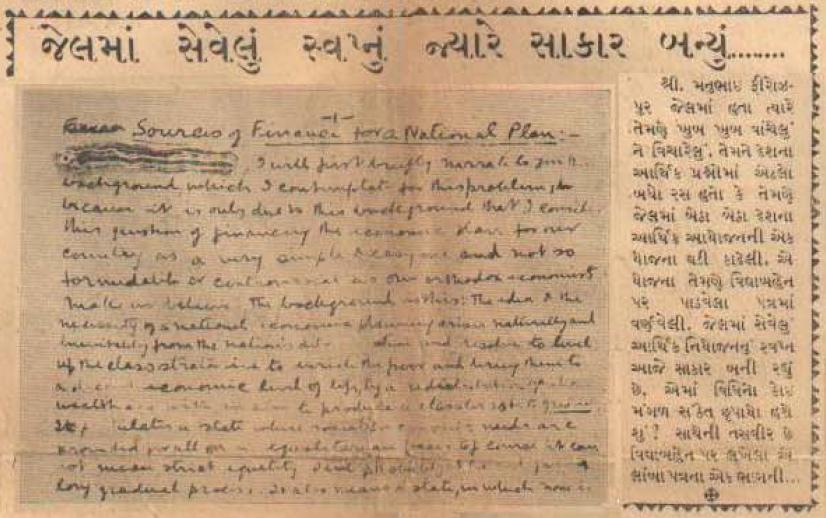
Such exchange of spirit and ideas and materials kept the Movement alive and also kept up the political spirit in the country, encouraging strikes and processions to continue to take place despite all the leading figures being in jail. In Ferozpur jail Manubhai went on a fast to protest against discriminating practices where offensive food was being served to certain categories of prisoners. For some months he also suffered from a severe attack of dysentery which was at first treated by an inmate Dr Yudhvir Singh who was a homeopath, but when the illness became life threatening, the other detenus then went on a hunger strike to force the jailors to fetch a doctor from Lahore. A German Dr Williamson arrived from Lahore who declared that he was astonished that the prisoner Manubhai was still alive. During this time negotiations were going on with the British, but failing. Like the Cripps Mission other efforts were also doomed to failure as they did not agree to the Indian demand for complete independence. Gandhiji had already been released from jail in 1944; and gradually of the 1200 prisoners in Ferozepur Jail most were out but Manubhai Shah and Ramjilal Bandhu and two others were the last to be released at the end of September 1945 only after Gandhiji wrote to the Home Minister Mr Tottenham that what these prisoners had done was nothing compared to the inhumane acts of violence of the British Government.[1]
We are reiterating some of these activities to remind our future generations what the tenor was of the Quit India Movement and though widely spread how essentially it was non-violent, and how independence of India was gained by the actions of thousands of people across the country, it was not attained by a single individual or a leader; it was a mass Movement in which were enjoined individuals from all nooks and corners of India; in all nooks and corners some action or the other was taking place unbeknownst to each other and unbeknownst to the world beyond; innumerable unsung noble warriers worked tirelessly to attain freedom, Vidyaben being one such who actively exhorted girls and boys of all ages around her to join the freedom struggle.
By 1933, during her school years, at the very young age of 11 years, Vidyaben had already been greatly influenced by the work of Gandhiji. During the 1930s and 1940s as a youngster Vidyaben had been participating in small ways on an everyday basis in the Freedom Movement in Gujarat as Gandhiji’s work was well known throughout Saurashtra. In her school, Sheth G. T. Girls' High School (Vanita Vishram), she had created a stir by bringing the message of nonviolence to her fellow students. In 1939, a Diwan in a princely state was committing atrocities on the common man and Gandhiji had started a movement against the Diwan. At the time Vidyaben was active in school and this protest against the Diwan influenced her greatly. Her school principal Sushilaben Pai was an enthusiastic Gandhian and she not only inspired Vidyaben but also allowed her to join protest activities as and when it was necessary as it meant missing school and Principal's permission became essential. Vidyaben had also been given encouragement by Urmila Mehta the Principal of Barton Female Training College which was near her own school. She had come to know Urmilaben as she used to like to watch cricket matches being played in a nearby play ground and that was only possible from Barton. Vidyaben had requested Urmilaben to allow her to enter her college to watch cricket, and which also gave them the opportunity to discuss affairs of global politics.
In 1942 when Gandhiji gave the call to do or die and the Quit India movement gained momentum, Vidyaben was a university student, and under the guidance of Gandhiji she readily joined hundreds of other volunteers who were waiting for such a moment. Vidyaben used to prepare and distribute pamphlets, put up posters, initiate rallies to awaken the youth and women, encouraging them to boycott foreign cloth, while in turn many a times she worried about her parents, as her father could lose his job as he was working for the British Raj in the Department of Education. She gave up eating sweets and ghee for three years until India became independent. After completing B.A. in Economics in 1943, as there was no postgraduate college in her parents' town, she left home to study for an M.A. at Samaldas College in Bhavnagar where she continued her work to force the British to Quit India.
When Vidyaben met Manubhai, he was already active in the freedom movement. Their chance meeting drew them towards each other and they felt even more inspired and certain of their commitment to the struggle. Vidyaben increased her activities, writing and distributing literature to invite others to join them, helping other people in the movement, making public speeches, going door to door to bring people out on the streets. As day by day the struggle grew in intensity, family members became concerned as it was impossible to predict what the outcome of the struggle would be and for how long it would go on for. But Vidyaben carried on nonetheless. They decided to not get married until freedom was certain. Manubhai and Aruna Asaf Ali worked closely together underground, and Vidyaben used to visit them in Delhi. Arunaji was a dynamic and dedicated person with utter honesty, integrity and passion for the oppressed Indians. On 9th August 1942, several leaders were arrested, but Arunaji went to Gowalia Tank and unfurled the National Flag. She escaped lathi charge, tear gas and other atrocities of the police, and went to Delhi. Subsequently Manubhai was caught, but all the time protected Aruna Asaf Ali by not letting anyone know where she was hiding. Vidyaben remained closely associated with her in Delhi through the activist years and even after 1947 until Arunaji's death in 1996. Vidyaben took risks, acted on advice from various teams around the country and worked hard making speeches, boycotting foreign goods, preparing and putting up posters, writing pamphlets and distributing them to the people of Gujarat to highlight the key issues for the future of India. But she did not get caught despite having sometimes received written instructions from colleagues describing how tiny bomb crackers can be made which would make small explosions but loud noise to scare the British government. Like Manubhai, Vidyaben also liked to make speeches exhorting people especially women to come out and join the struggle.
Vidyaben along with the renowned homeopath
After Manubhai was released from jail in 1945, Vidyaben and he got married; they had already waited for each other for five years. They continued to be active in the freedom struggle but at the same time Manubhai went back to work for Delhi Cloth Mills so that he could also support the growing family.
After India became independent, Manubhai continued to work for DCM, though he used to regularly attend the weekly prayer meeting held by Mahatma Gandhi at
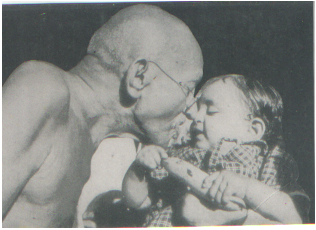
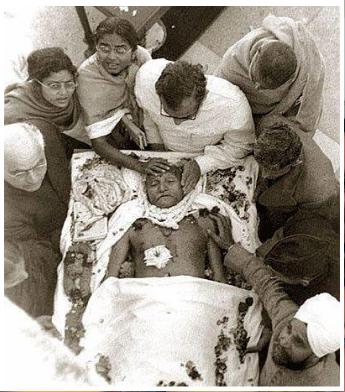
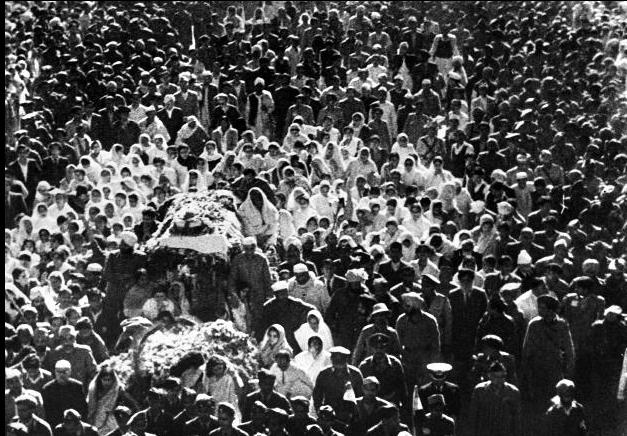
The atmosphere in Gujarat in the immediate years post-independence was highly charged and everyone had joined up to build India. There was great fervour, and on the streets, in industry, in theatres, in schools and colleges the only talk to be heard was about integration and reconstruction. Gandhiji was very much present in people's hearts. The photographs below show how young girls and women had joined the Homeguard movement in Rajkot in an attempt to contribute what little they could towards India's future. It was as if the freedom struggle was an ongoing movement; a struggle towards true freedom and true democracy, free of corruption and full of endeavour and determination.
Vidyaben being felicitated for her long and determined participation in the Quit India Movement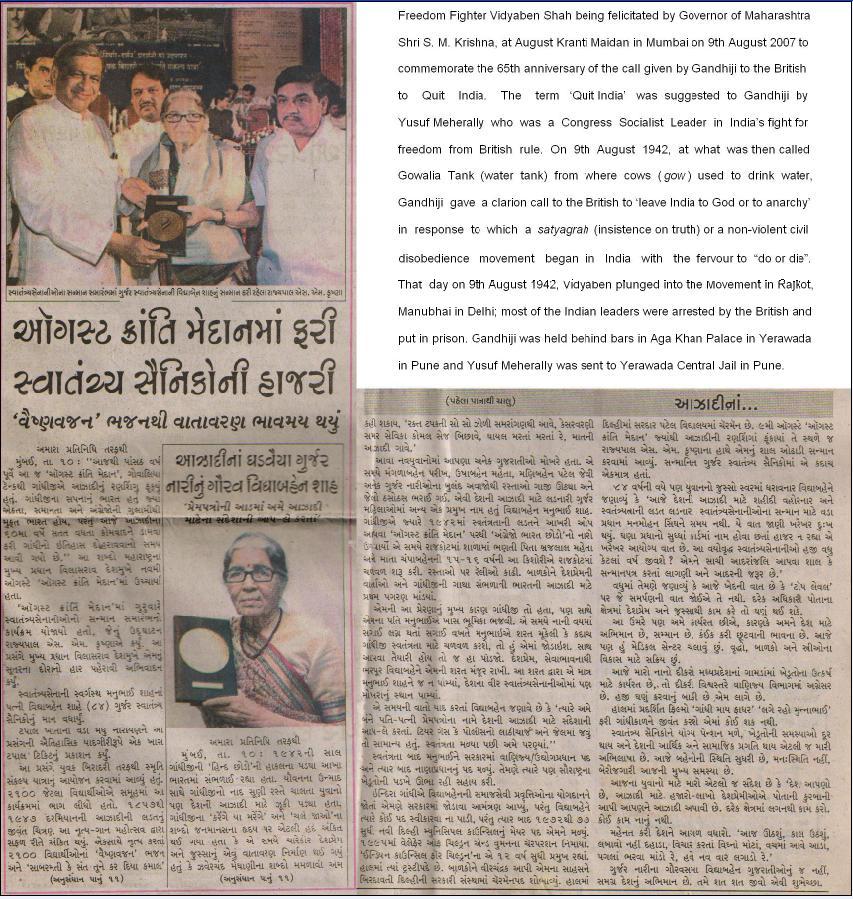
References
-
^ Click here to read some of these narratives which can be found in the Chapter on Manubhai Shah in Freedom Fighters Remember (1997), Ed. Naveen Joshi, Published by the Publications Devision, Ministry of Information and Broadcasting, Government of India.
CLICK BELOW TO VIEW OTHER PAGES ON VIDYABEN SHAH & MANUBHAI SHAH
Culture, Civics, Institutions What people said